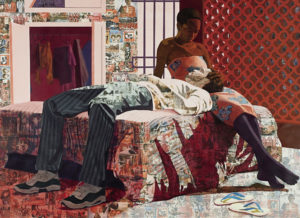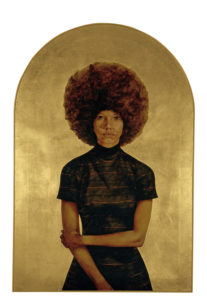CHARLESTON, S.C., March 5, 2019 – The Gibbes Museum of Art is pleased to present Black Refractions: Highlights from The Studio Museum in Harlem, a major traveling exhibition organized by the American Federation of Arts (AFA) in collaboration with The Studio Museum in Harlem. The exhibition presents nearly a century of works by artists of African descent. The Gibbes’ showing of Black Refractions includes over 70 works by more than 50 artists across all media dating from the 1920s to the present and will be on display at the museum from May 24–August 18, 2019. More than a dozen artists in the exhibition have lasting connections to the American South including Romare Bearden, Thornton Dial, Sam Gilliam, Clementine Hunter, Kerry James Marshall, Alma Thomas and Bill Traylor.

Black Refractions is a landmark initiative that explores the vital contributions of artists of African descent, proposing a plurality of narratives of black artistic production and multiple approaches to understanding these works. Through its pioneering exhibitions, public programs, artist residencies and bold acquisitions, The Studio Museum in Harlem has served as a nexus for artists of African descent locally, nationally, and internationally since its founding in 1968.
“Black Refractions is a once-in-a-lifetime opportunity for the Charleston community to experience these incredible works of art,” said Angela Mack, the Gibbes Museum of Art’s executive director. “At the Gibbes, we focus on diversifying and expanding our permanent collection to include works from a number of artists with differing perspectives. In the last 10 years, we are proud to have doubled the number of works by African American artists and look forward to continuing to build our collection to reflect Charleston’s diverse population.”

Artists featured in the Gibbes Museum’s presentation:
Njideka Akunyili Crosby, Charles Alston, Benny Andrews, Romare Bearden, Dawoud Bey, Chakaia Booker, Frank Bowling, Jordan Casteel, Elizabeth Catlett, Eldzier Cortor, Noah Davis, Beauford Delaney, Thornton Dial, Leonardo Drew, Melvin Edwards, Sam Gilliam, David Hammons, Lyle Ashton Harris, Maren Hassinger, Barkley L. Hendricks, Richard Hunt, Clementine Hunter, Juliana Huxtable, Isaac Julien, Titus Kaphar, Jacob Lawrence, Hughie Lee-Smith, Norman Lewis, Glenn Ligon, Kalup Linzy, Tom Lloyd, Whitfield Lovell, Al Loving, Kerry James Marshall, Adia Millett, Wangechi Mutu, Kori Newkirk, Otobong Nkanga, Odili Donald Odita, Lorraine O’Grady, Jennifer Packer, Faith Ringgold, Betye Saar, Jacolby Satterwhite, Gary Simmons, Lorna Simpson, Shinique Smith, Alma Thomas, Mickalene Thomas, Hank Willis Thomas, Bill Traylor, James VanDerZee, Nari Ward, Carrie Mae Weems, Jack Whitten, Kehinde Wiley, William T. Williams, Fred Wilson, Hale Woodruff and Lynette Yiadom-Boakye.
Publication
Black Refractions is accompanied by a new publication of the same title co-published by the American Federation of Arts and Rizzoli Electa. The richly illustrated volume includes essays by Connie H. Choi and Kellie Jones; entries by a range of writers, curators and scholars (among them Lauren Haynes, Ashley James, Oluremi C. Onabanjo, Larry Ossei-Mensah and Hallie Ringle) who contextualize the works and provide detailed commentary; and a conversation among Choi, Thelma Golden, and Jones that draws out themes and challenges in collecting and exhibiting modern and contemporary art by artists of African descent.
Curator
Connie H. Choi is Associate Curator, Permanent Collection, at The Studio Museum in Harlem, where she has worked on the exhibitions Regarding the Figure (2017), Fictions, and Their Own Harlems (both 2017–18). Prior to joining the museum in 2017, Choi was the Assistant Curator of American Art at the Brooklyn Museum. She is a PhD candidate in art history at Columbia University, and holds a BA in the history of art from Yale University and an EdM in arts education from Harvard University.
Credit
Major support for Black Refractions: Highlights from The Studio Museum in Harlem is provided by Art Bridges, a pioneering new philanthropic foundation dedicated to expanding access to American art for audiences across the country. Art Bridges is pleased to support Black Refractions and its vital role in bringing nearly a century of art by artists of African descent to new and diverse audiences across the United States. Support for the accompanying publication provided by Furthermore: a program of the J.M. Kaplan Fund.
About the Gibbes Museum of Art
Home to the Carolina Art Association, established in 1858, the Gibbes Museum of Art is recognized among the oldest arts organizations in the United States. Housing one of the foremost collections of American Art from the 18th century to the present, the museum’s mission is to enhance lives through art by engaging people of every background and experience with art and artists of enduring quality and by providing opportunities to learn, to discover, to enjoy and to be inspired by the creative process. For more information, visit www.gibbesmuseum.org.
About the American Federation of Arts
The American Federation of Arts is the leader in traveling exhibitions internationally. A nonprofit organization founded in 1909, the AFA is dedicated to enriching the public’s experience and understanding of the visual arts through organizing and touring art exhibitions for presentation in museums around the world, publishing exhibition catalogues featuring important scholarly research, and developing educational programs.
About The Studio Museum in Harlem
Founded in 1968 by a diverse group of artists, community activists and philanthropists, The Studio Museum in Harlem is internationally known for its catalytic role in promoting the work of artists of African descent. As it celebrates its 50th anniversary, the Studio Museum is preparing to construct a new home at its longtime location on Manhattan’s West 125th Street, designed by internationally renowned architect David Adjaye of Adjaye Associates in collaboration with Cooper Robertson. The first building created expressly for the institution’s program, the new building will enable the Studio Museum to better serve a growing and diverse audience, provide additional educational opportunities for people of all ages, expand its program of world-renowned exhibitions, effectively display its singular collection and strengthen its trailblazing Artist-in Residence program.
While the Studio Museum is currently closed in preparation for construction, the Museum has opened Studio Museum 127, a temporary programming space located at 429 West 127th Street, and is working to deepen its roots in the community through inHarlem, a dynamic set of collaborative programs in our neighborhood. The Museum’s groundbreaking exhibitions, thought-provoking conversations, and engaging art-making workshops continue at a variety of partner and satellite locations in Harlem and beyond.
###
Media Contacts
Lou Hammond Group
Hannah Buffington / Lauren Van Liew
[email protected] / [email protected]
(843) 410-5306 / (843) 410-4688
Top image: Echoes of Harlem, 1980, By Faith Ringgold (American, b. 1930); Hand-painted cotton; 80 ½ x 89 ½ inches; The Studio Museum in Harlem; gift of Altria Group, Inc. 2008.13.10
Published March 5, 2019

